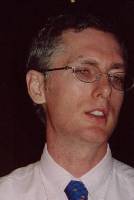


Venomous Country
Participants
Venomous Country
Endnotes
Index
Search
Help
Contact us

Ken Winkel: Mick do you have any insight into the way in which resources were allocated? Struan seemed to be fortunate to have the tap switched on in 1970 or so to allow him to build a team.

Photograph courtesy of Ann Westmore
Mick Kornitschuk: When Struan was put into a separate area, as Bob [Premier] was saying, away from everybody else, he still continued his research. But he found that a lot of his equipment wasn't following him. I remember talking to Struan and he mentioned that he'd like to have a new centrifuge, and this or that piece of equipment. The strange thing was that he would put in a purchasing requisition, he had to fight for it, but he did get a lot of the equipment he wanted.
Now, on leaving CSL, what was he going to do? Was he going to leave it behind or was he going to take it with him? And I'm sure you're all aware now that he did take a lot of the equipment with him. I remember him looking at some of the equipment and quoting the relevant purchase order. You'd be surprised how much of the equipment he took with him to the University of Melbourne, without any murmurs from CSL, although some of it was not specifically earmarked for him, he would look at it, hum and ha, and say, yes that's mine. He was working with it and nobody else wanted it. He loaded everything up and the room was emptied.
Ken Winkel: Comment from Melbourne University. [Laughter]
Jim Angus: Things do happen in mysterious ways. But I did receive a phone call from the [CSL] hierarchy and I agreed to look after the insurance of it. And it was a loan to the University. But I had been around before and heard about loans and usually, as a scientist, your equipment moves with you. And if we, as a group of scientists, can't allow that to continue, whatever the circumstances, we don't deserve to be scientists. Here is a case where CSL said they recognised that Struan needed some tools, they agreed to lend it to the University but I knew that was a gift. And we were very fortunate to have it.
Ken Winkel: Perhaps if we could move on to the funnel web topic in particular. Once again, going through Struan's remarkable files I found this particular photograph demonstrating the response to the funnel web spider antivenom in experimental monkeys. It shows monkey Megan - I'll let others explain the significance of that name - after receiving 0.5 mg of male funnel web venom 90 minutes previously and antivenom intravenously 10 minutes after that. The second monkey in this photograph received the same dose of venom 60 minutes previously, but no antivenom. Perhaps if the team from CSL would look at this image and tell us the story of these two monkeys.
Alan Coulter: Well, Megan was Struan's second wife. I'm not sure why he called the monkey Megan. There's an interesting story about the funnel web antivenom. Struan had some rabbits that he wanted to dose with funnel web venom. I'm not sure why he chose rabbits, perhaps someone else can explain that. One of the reasons may be that we had a new system where we could fractionate rabbit serum and purify the immunoglobulins from it. I think Rodney and I gave these rabbits their first dose of funnel web venom. After their first dose, Struan gave the rabbits all subsequent doses. This may have been because he wanted to have a closer relationship with the rabbits. He used to feed them carrots, which was very unusual for scientific staff back in those days. In Struan's eyes, these rabbits were very special.
 |
Witness to the History of Australian Medicine |  |
© The University of Melbourne 2005-16
Published by eScholarship Research Centre, using the Web Academic Resource Publisher
http://witness.esrc.unimelb.edu.au/083.html